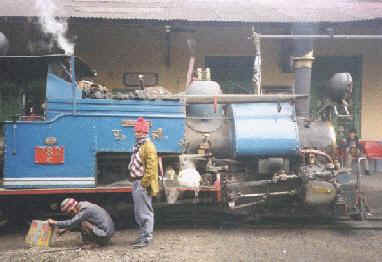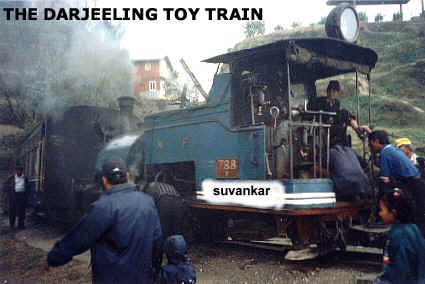



|
Trains came to India in the early part of the last century --
among the very first and most novel, is the famous Toy Train
of Darjeeling. It is 117 years old having made its maiden
trip in the September of 1881. Officially known as the
Darjeeling Himalayan Railway, it is as much a pioneering work of
achievement, projecting not only its engineering ingenuity but
also a historic development of the 19th century British
convalescent center in the remote north eastern Himalayas.
In 1870, an agent working for the Eastern Bengal Railway came
up with a brilliant idea to reduce the costs of transport. His
name Franklyn Prestage -- the idea -- the Toy Train. It took
eight long years for Prestage to submit his scheme to Lt.
Governor Sir Ashley Eden, who gave it immediate sanction. Named
the Darjeeling Steam Tramway Co., it was changed to The
Darjeeling Himalayan Railway Co. on September 15th 1881. It
remained as such till it was taken over by the Indian Government
on Oct. 20, 1948. The construction had begun in 1879 and with
the zeal shown by the workers, the first 20 miles from Siliguri
to Tindharia station was opened in March 1880 for the Viceroy's
special train only. After a further 11 miles to Kurseong were
completed, it was opened to the public on August 23 of that
year. Sonada was reached on February 1, 1881, the summit of
Ghoom on April l4th, 1881 and finally on July 4th 1881 the baby
locomotive and three coaches puffed right through to
Darjeeling-a total of 50.75 miles.
In 1914, the Darjeeling Himalayan Railway (DHR) was further
extended down south towards Kishanganj and close to the Nepalese
frontier for jute traffic and in 1915. Meantime the DHR was
extended from Siliguri toward Sevoke by 10 miles and further to
the north 16 miles on Kalimpong road. Until 1878, the journey
from Calcutta to Darjeeling took from 5 to 6 days by the East
Indian Railway from Howrah to Sahebganj, then by steam ferry
across the Ganges to Charcoal, then by bullock carts on the
river opposite Danger Hat, after crossing again by bullock cart
or 'palki' (palanquin) to Purnea, Kishanganj, Titalya and
Siliguri whence the ascent commenced via the Punkhabari road
which finally joins the present cart road at Kurseong. In 1878,
Siliguri was put on the map of the railway, the journey was cut
to two days and another six to seven hours to Darjeeling.
Running on south at about the 22nd kilometer, is another
beautiful and somewhat complicated loop. After winding through a
third loop, at Chunamandi (2,000ft) the train comes to its
"Z" crossing or switchback at about a distance of 28
km. Here, it starts zigzagging or reversing to attain a higher
elevation, The first big station, Tindharia, 37 km from Siliguri,
is at a height of 860 meters and has a workshop for repairs.
Leaving the station, the train passes another "Z' crossing
and at a distance of 6 km is Gayabari station at a height of
3,516feet where the line runs close to the edge of a precipice,
the mountain terraced with tea bushes and wild flowers in
flaming colors while in the distance is Pagla Jhora or "Mad
Torrent", a roaring, cascading waterfall. This is the chief
outlet of rainfall due to the clouds striking against Mahaldiram
Range and after a heavy rain this course is a roaring torrent in
which large boulders are helplessly tossed about. The train has
now covered half the distance to Darjeeling. Soon the train leaves this delightful station, fog appears
and all of sudden is gone -- a will o' the wisp -- Mount
Kanchenjunga first leaps into view showing off its mighty
majesty. Running generally along the old Hill Cart road, the
train reaches Toong station at an elevation of 1,724 meters
(5,565 ft) and 8 kilometers from Kurseong. Toong abounds in
Toomi trees. Sonada, enveloped in dense fog, at an elevation of
1,997 meters (6,552 ft) is eight kilometers away. The abode of
bears, Sonada provides Darjeeling with its milk and fruits. Many
tea gardens converge here along the Hope Town spur. It is also
an important vegetable growing center.
Looking like a caterpillar, the train continues winding along
the twisted paths crawling alongside, almost hugging the side of
the hill. Ascending gradually, the train reaches Jore Bungalow
Bazaar, from where a road leads to Senchal Lake, Tiger Hill,
Kalimpong and the many tea gardens lying ahead. Soon it will
reach the last town on the Indo-Nepal frontier -- Ghoom.
Situated at an altitude of 2,225.7 meters (7,407 ft), Ghoom is
the highest rail-road station in the world and the home of a
Tibetan Buddhist Monastery. After Ghoom, the train starts
descending towards Darjeeling for a distance of 6 km and the
line falls about 182.9 meters (1,000 ft). In between is the
graceful double loop -- Batasia -- from where a grand view of
Darjeeling in all its glowing beauty presided over by mighty
Kanchenjunga with all the other peaks-the land of perpetual
snows, bursts before the eyes of the eager traveler.
Constructed on spurs of the Himalayan hills, the loops, once
named "Sensation Corner" and "Agony Point",
are very good viewing points and the passengers get the feel of
the sheer drop below. No tunnels were ever dug since it was
desired that the traveler got full views of the ever-changing
scenery.
|
|---|
COPYRIGHT: SUVANKAR SANYAL, ALL RIGHTS RESERVED